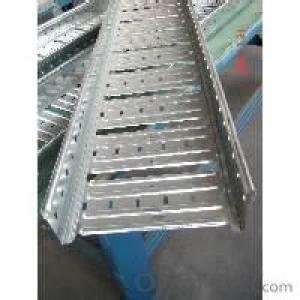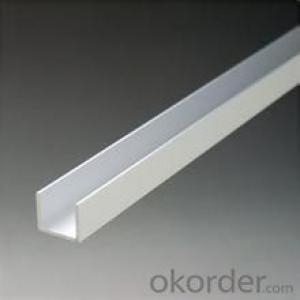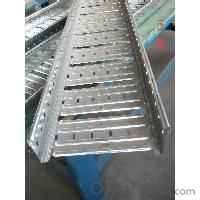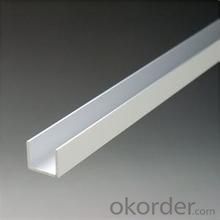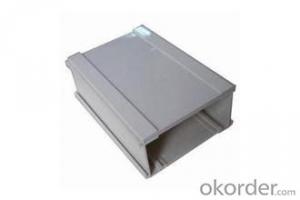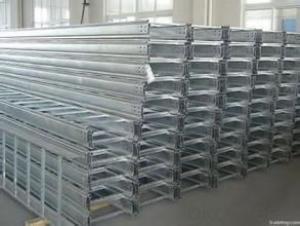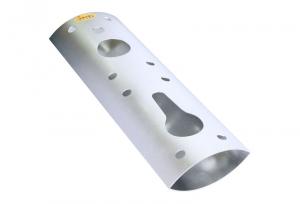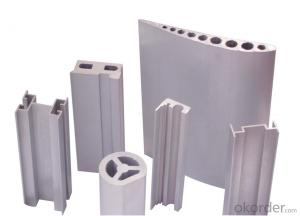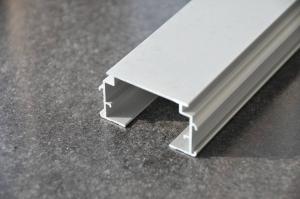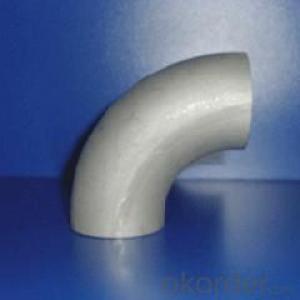Bosch Extruded Aluminum Profiles for Alu Profile Section H Cable Tray
- Loading Port:
- China Main Port
- Payment Terms:
- TT OR LC
- Min Order Qty:
- -
- Supply Capability:
- -
OKorder Service Pledge
OKorder Financial Service
You Might Also Like
Aluminium is a relatively soft,durable, lightweight, ductile and malleablemetal with appearance ranging from silvery to dull gray,depending on the surface roughness. It is nonmagnetic and does not easilyignite. A fresh film of aluminium serves as a good reflector (approximately92%) of visible light and an excellent reflector (as much as98%) of medium and far infrared radiation. The yield strength of pure aluminium is 7–11 MPa,while aluminium alloys have yield strengths ranging from200 MPa to 600 MPa. Aluminium has about one-third the density and stiffnessof steel. It iseasily machined,cast, drawn and extruded.
Alu Profile:
Material | Alloy 6063,6061,6005or according to customer’s choice |
Temper | T3, T4, T5, T6 |
Surface | Anodize, electrophoresis, powder coating, PVDF coating, wood grain painting, matted, etc. |
Length | Coating 6.5 meters, Anodizing 6.5 meters, Mill finish 5 meters |
Application | Industrial, electrical equipment(TV set, air conditioner, refrigerator, computer), decoration,construction, transportation |
Custom Made | We can package following with customer's request. |
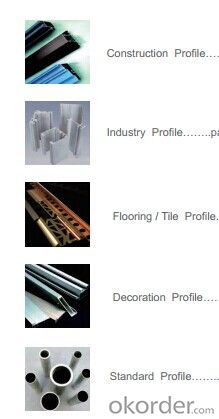
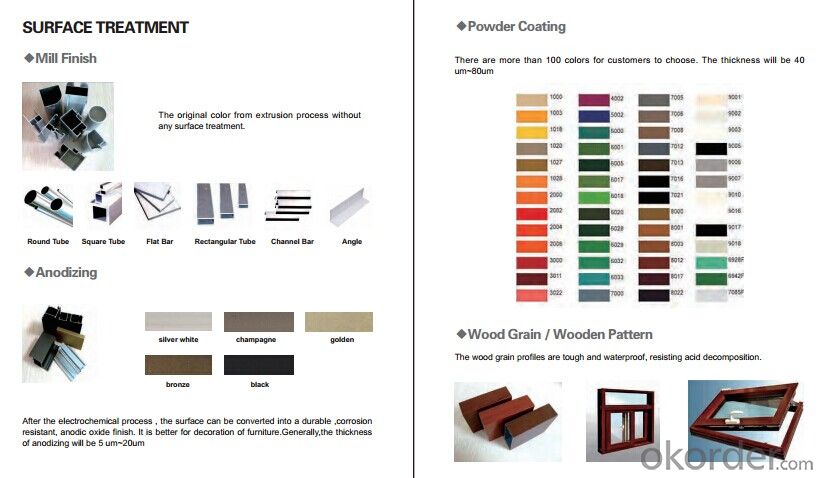
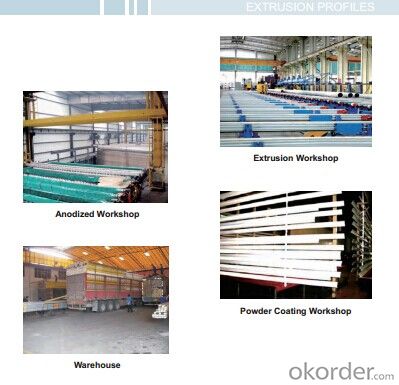
FAQ:
1. What is the form of payment?
Normally 30% TT, L/C at sight
2. Type of quotation?
FOB, CFR, CIF
3. Port of loading?
Guangzhou/Shenzhen port
4. Delivery time?
15-20 days after client’s deposit
- Q: What are the standard dimensions of aluminum profiles?
- The standard dimensions of aluminum profiles can vary depending on the specific industry and application. However, there are some common standard dimensions that are widely available. In general, aluminum profiles come in a variety of shapes and sizes, including rectangular, square, circular, and custom shapes. The most common dimensions for rectangular aluminum profiles are typically between 1 inch to 6 inches in width and 1/2 inch to 4 inches in height. Square profiles often range from 1 inch to 4 inches in width and height. Circular aluminum profiles, also known as tubes or pipes, are typically available in various outer diameters ranging from 1/4 inch to 8 inches, with wall thicknesses ranging from 1/16 inch to 1/2 inch. It's important to note that these are general standard dimensions and there can be variations depending on the manufacturer and specific requirements of a project. Additionally, custom dimensions can be manufactured to meet unique specifications. When selecting aluminum profiles, it's crucial to consider the intended application and load-bearing requirements to ensure the chosen dimensions can adequately support the intended use.
- Q: How to prevent the aging of aluminum profile hardness is not enough?
- Raw materials, alloy, cast bar qualityDuring extrusion, the outlet temperature is guaranteed to be above the solid solution temperature,Cooling, quenching speed guaranteed as fast as possible
- Q: How much is aluminum freight per kilometer per ton?
- The most accurate and effective way of Logistics: find a phone call to ask ah, less than 1 tons and tons of vehicle and hair are not the same, where to go is not the same, some small place to transfer is much more expensive, General Logistics 1 tons in about 500
- Q: Is it possible to recycle and reuse aluminum profiles?
- <p>Yes, aluminum profiles can be recycled and reused. Recycling aluminum is an efficient and environmentally friendly process, as it requires significantly less energy compared to producing aluminum from raw materials. Recycled aluminum maintains its properties, making it suitable for various applications. The recycling process involves melting the aluminum, which can then be reformed into new profiles without losing its strength or quality. This practice reduces waste and conserves natural resources, contributing to sustainability efforts.</p>
- Q: How much is the 60 series aluminum frame bridge standard size, how much is the size of the fan
- In the Canton aluminum 60 series, the broken bridge is 59.2*67; the fan is 67.2*93
- Q: This question asks for methods to ensure the reliable and durable installation of aluminum profiles.
- <p>To ensure the reliable and durable installation of aluminum profiles, follow these steps: Use high-quality aluminum materials that meet industry standards for strength and durability. Ensure proper alignment and level during installation to prevent warping or stress on the profiles. Use appropriate fasteners and adhesives recommended for aluminum to ensure a strong bond. Avoid over-tightening fasteners, which can cause deformation. Regularly inspect and maintain the profiles to check for signs of wear or damage, and address any issues promptly. This will help maintain the integrity and longevity of the aluminum profiles.</p>
- Q: This question asks for the proper and safe method of installing aluminum profiles, which are commonly used in construction and manufacturing.
- <p>To install aluminum profiles correctly and safely, follow these steps: 1. Plan the layout and measure the required lengths accurately. 2. Use appropriate cutting tools to cut the profiles to size, ensuring a clean edge. 3. Apply protective gloves and eyewear when handling aluminum profiles to avoid injury. 4. Use the correct fasteners, such as screws or bolts, compatible with the aluminum profiles. 5. Ensure the profiles are securely fastened and aligned properly. 6. Check for any sharp edges or burrs after installation and smooth them out to prevent injury. 7. Always follow the manufacturer's guidelines and safety precautions. Proper installation and safety measures will ensure the longevity and stability of the aluminum profiles.</p>
- Q: Can aluminum profiles be used in railway and transportation infrastructure?
- Certainly, railway and transportation infrastructure can make effective use of aluminum profiles. Aluminum, being a lightweight and durable material, presents numerous advantages in these specific applications. The utilization of aluminum profiles in railway and transportation infrastructure offers a primary benefit, which is their low weight. Compared to materials like steel, aluminum is significantly lighter, making transportation and installation simpler. This reduction in weight can also result in energy savings since it requires less fuel to move the infrastructure components. Furthermore, aluminum profiles possess a high strength-to-weight ratio, enabling them to withstand heavy loads while remaining relatively lightweight. This characteristic makes them suitable for various structural purposes, such as supporting overhead power lines, constructing platforms, and forming the framework for bridges and tunnels. Aluminum also exhibits excellent resistance to corrosion, which is crucial in railway and transportation infrastructure that is exposed to harsh weather conditions and environmental elements. Aluminum profiles can endure moisture, UV rays, and other corrosive agents, thereby reducing maintenance requirements and prolonging the lifespan of the infrastructure. Moreover, aluminum profiles can be easily fabricated and customized to meet specific design requirements. They can be extruded into diverse shapes and sizes, allowing for flexibility in design and construction. Additionally, aluminum profiles can be readily joined together using different methods, such as welding or fastening, ensuring ease of assembly and disassembly if necessary. In conclusion, it is indeed possible to employ aluminum profiles in railway and transportation infrastructure. Their lightweight nature, high strength, corrosion resistance, and versatility make them an exceptional choice for various structural and functional applications within these sectors.
- Q: This question asks for a list of various fastening methods or components used to attach aluminum profiles in roofing systems.
- <p>In roofing systems, various types of fasteners are used to secure aluminum profiles, ensuring stability and longevity. Some common fasteners include: 1. Self-tapping screws, which thread directly into the aluminum without pre-drilling. 2. Rivets, which join two pieces of aluminum by compressing them together. 3. Nuts and bolts, used in conjunction with pre-drilled holes for a secure fit. 4. Clamps, which hold profiles together without penetrating the material. 5. Adhesives, used for bonding profiles in situations where mechanical fasteners are not suitable. 6. Clips and brackets, which can be used to attach profiles to other structural elements. Each type of fastener has its specific application and is chosen based on the design requirements and environmental conditions of the roofing system.</p>
- Q: How do you calculate the strength of aluminum profiles?
- To calculate the strength of aluminum profiles, there are several factors that need to be considered. 1. Material properties: The first step is to know the mechanical properties of the aluminum alloy being used, such as its yield strength, ultimate tensile strength, and elastic modulus. These properties can be obtained from material data sheets or testing. 2. Cross-sectional area: The next step is to determine the cross-sectional area of the aluminum profile. This can be done by measuring the dimensions of the profile or referring to its specifications. The cross-sectional area is typically calculated by multiplying the width and height of the profile. 3. Load calculation: Once the cross-sectional area is known, the next step is to calculate the applied load on the profile. This can be determined by considering the weight or force that will be acting on the profile. The load can be static or dynamic, and it is important to account for any potential variations or impacts. 4. Stress analysis: With the load and cross-sectional area determined, the stress on the aluminum profile can be calculated using the formula: Stress = Load / Cross-sectional area. This will give the stress value in units of force per unit area (e.g., N/m2 or psi). 5. Safety factor: To ensure the profile's strength is adequate, a safety factor is typically applied. The safety factor accounts for uncertainties in the load calculations and ensures the profile can handle unexpected loads or variations. Common safety factors range from 1.5 to 4, depending on the specific application and industry standards. By considering these factors and performing the necessary calculations, it is possible to determine the strength of aluminum profiles and ensure they meet the required safety standards for their intended applications.
Send your message to us
Bosch Extruded Aluminum Profiles for Alu Profile Section H Cable Tray
- Loading Port:
- China Main Port
- Payment Terms:
- TT OR LC
- Min Order Qty:
- -
- Supply Capability:
- -
OKorder Service Pledge
OKorder Financial Service
Similar products
Hot products
Hot Searches
Related keywords
